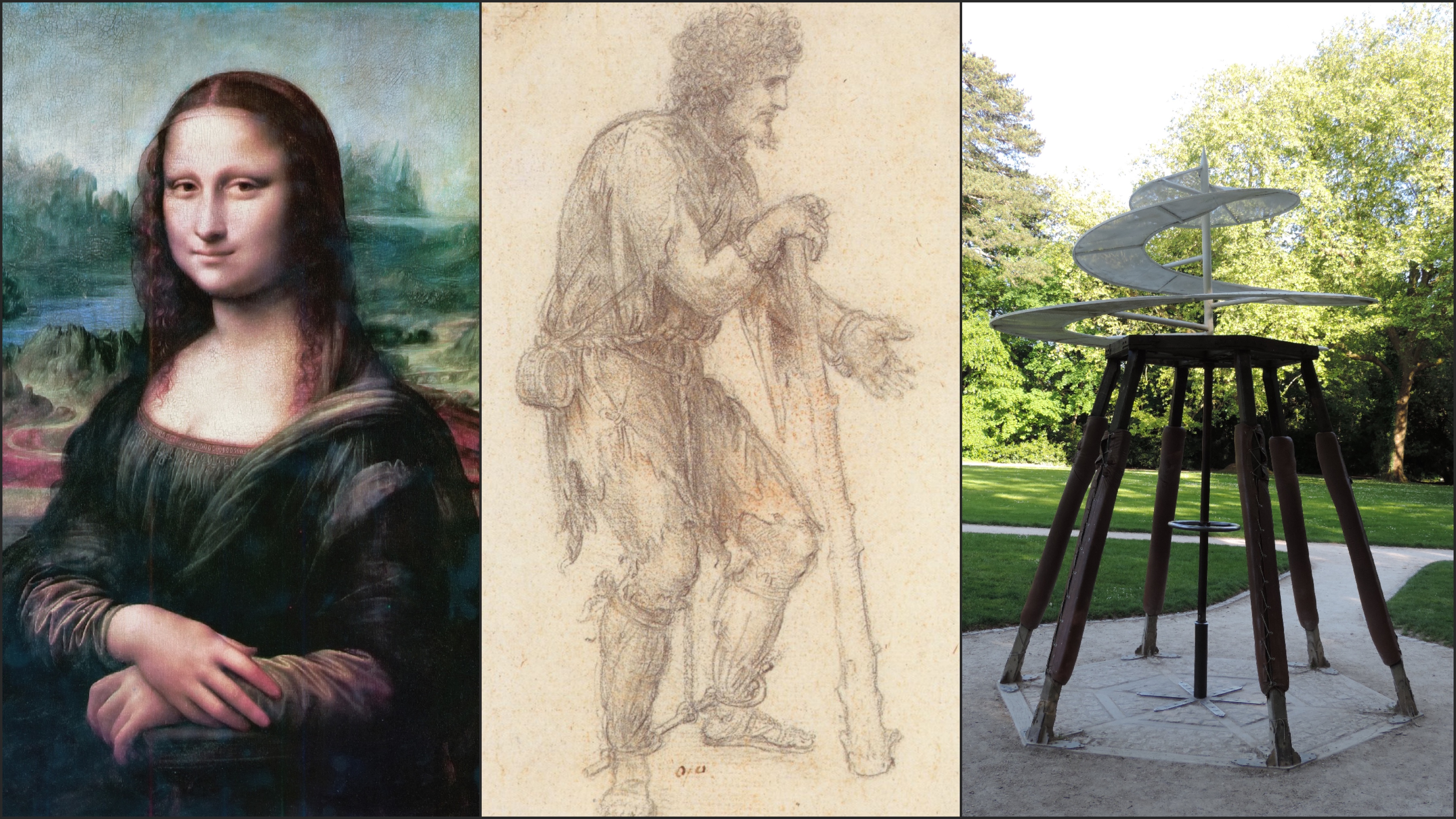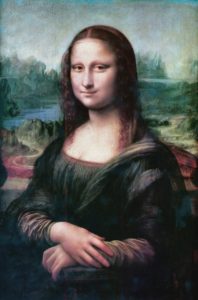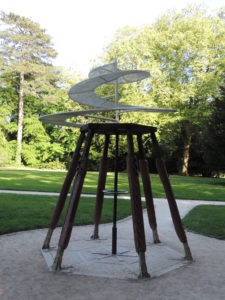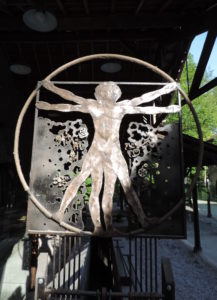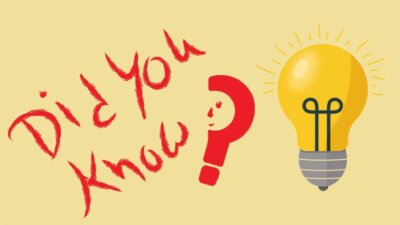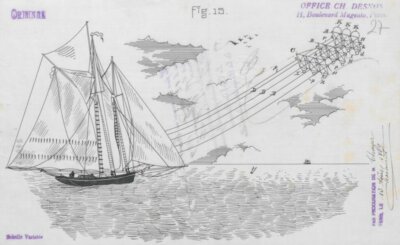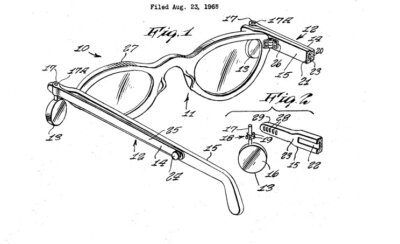You may have already been informed of this event given the communication relating to this subject since the beginning of the year.
At the same time of being an artist, Leonardo da Vinci was a great inventor and a visionary of his time. So, why not just pay a tribute to him since we share the same taste for discovery?
Son of Ser Piero, notary of the seignory of Florence, and a farmer’s daughter, Leonardo di Ser Piero da Vinci was born in Vinci, near Florence, Italy, in 1452 and died in the Manoir du Cloux (today Clos-Lucé Castle), in Amboise, France, in 1519.
His life and beginnings in Florence
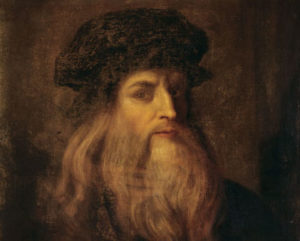 In 1469, Leonardo da Vinci worked in Verrochio’s workshop and learnt there the basics of painting and sculpture, including perspective (Annunciation, 1473, Ginerva de’ Benci, 1478-1480).
In 1469, Leonardo da Vinci worked in Verrochio’s workshop and learnt there the basics of painting and sculpture, including perspective (Annunciation, 1473, Ginerva de’ Benci, 1478-1480).
He learned a technique called “sfumato”, a sort of veil that dilute plastic masses in a more suggestive and poetic reality. This technique makes imperceptible the transition between colors, shadows and lights (Adoration of the Magi, around 1481, unfinished).
In Milan
To take part in the dissemination of the Florentine know-how, at the request of Lorenzo de Medici, he moved to Milan in 1482 where he served as a military engineer, an architect, a painter, a sculptor and he also organized celebrations in the Sforza’s court.
He worked for 16 years on the equestrian statue of Francesco Sforza, a huge work that was never melted. He also participated in the discussion about the construction of Milan’s and Pavie’s Cathedrals and painted two pictures: Virgin of the Rocks, around 1482-1483, and The Last Supper, 1497.
The Mona Lisa
In 1499, the Duchy of Milan fall into the hands of the French and Leonardo da Vinci left for Mantova where he made the portrait of Isabelle d’Este. In Rome, he worked as a military engineer for Cesar Borgia, then he returned to Florence.
There, he painted the Mona Lisa around 1503-1507 and The Virgin and Child with Saint Anne towards 1508-1510. The Battle of Anghiari, a mural painting for the Palazzo Vecchio (around 1503-1505), is only known from drawings, as the Leda (between 1504 and 1508).
Latest Journeys
In 1508, he came back to Milan where Bernardino Luini and Andrea Solario will become his disciples. He then made an equestrian monument for the Condottiere Trivulce’s tomb (1511-1512). Later, he spent two years in Rome where he is called by Giuliano de Medici. From this period remains the Saint John the Baptist from the Louvre (around 1514-1515). Finally, in 1516, he responded to the offer of François 1st, who invited him to his royal court and settled him in Manoir du Cloux (now Clos-Lucé Castle), near Amboise Castle. There, he will draw the plans of a perfect castle for the King of France. François 1st himself confided that he did not believe that “a man had so much knowledge”.
Scientist and engineer: the passion of knowledge
Leonardo da Vinci was interested in all branches of science, as is shown in his writings and sketchbooks (collections of the Clos-Lucé and of the Windsor Castle, in Great Britain). As a scientist, he was interested in the visible universe, in its structures and its movements. He died in the Clos-Lucé Castle on April 23rd, 1519.
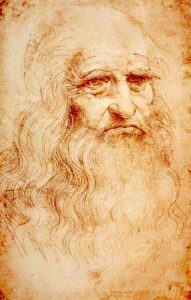 This solitary master of innovation, stoic and serene, refused the authority and based his judgment on experience.
This solitary master of innovation, stoic and serene, refused the authority and based his judgment on experience.
He is not a scientist bringing revolution in science with his discoveries and hypotheses, like Copernic or Newton. While celebrating “the supreme certainty of the mathematics”, he is above all a “visual person” for whom the eye, “window of the soul, is the main route by which our intellect can appreciate the infinite work of nature”. His curiosity refuses all distinctions between pure science and applied science, between fine arts and mechanical arts.
Three fields of predilection
His research focused on various fields as astronomy and geology, geometry and the mechanics, optic and acoustic, botanic and metallurgy. But three main fields stand out from its notebooks due to the abundance and singularity of his notes.
-
Firstly, the anatomy: meticulous descriptions, multiple dissections illustrated with beautiful drawings, some dedicated to the comparative anatomy. He is a sort of precursor of Vesalius, father of modern anatomy. (Leonardo da Vinci, study of shoulder muscles).
-
Then, the mechanics, applied to the engineering work (ballistic inventions, army tanks, pumps and dredges, bridges and canals) and to flying machine projects of which sketches are based on the flight of birds. He also imagines a suit used to dive, ancestor of the diving suit, or even the spring tricycle.
-
Finally, the earth globe life, through the mechanics of fluids and geology: studies of swirls, panoramic drawings that show the formation of Alpine valleys, analysis of fossils, shape of the shells, etc.
Esthetic heritage
In the continuity of all aspirations of this century, Leonardo da Vinci did complete, in painting, his chiaroscuro’s work, of which the impact was so decisive. Author of only 18 completed paintings, he left behind a heritage of an immense value.
It is completed with theorical writings, published in French in 1942 and untitled “Carnets de Léonard de Vinci” (Leonardo da Vinci’s notebooks). They include the Treatise on Painting, conceived in 1490 and published in 1651.
A few quotes from Leonardo da Vinci
“In time of peace, I can equal, I think, anyone in architecture, erect private and public buildings, and conduct water from one place to another” – In a letter addressed to the Duke of Milan, Ludovic Sforza le More.
“Painter, do not decline your colors in the perspective more than the figures that wear these colors” – A Treatise on Painting
“The divine nature of painting makes the spirit of the painter turn into an image of God’s Spirit.” – A Treatise on Painting
To discover, deepen or rediscover Leonardo da Vinci:
In France:
-
The exhibition “The Death of Leonardo da Vinci: the construction of a myth”, organized in the Amboise Castle, in partnership with the BNF (National Library of France).
From 2 May to 2 September.
Workshops, exhibitions, concerts, escape games… Full program of events is available on the “Leonardo da Vinci 2019” website. -
Clos Lucé events: http://www.vinci-closluce.com/en/events
-
From 24 October 2019 to 20 February 2020, an exceptional retrospective about “Leonardo da Vinci” in the Louvre Museum, in Paris.
Reservation, required, will be opened from 18 June.
More information coming soon on the Louvre Museum Website.
In Italy:
-
Numerous exhibitions are held in Vinci and Florence, one of which is “Leonardo and Florence”, where some extracts of the Codex Atlanticus will be exhibited until 24 June.
More information on the Florence Museums website. -
Exhibition “Leonardo da Vinci. Parade”: until 13 October, the City of Milan will host a selection of machines built according to the plans of the inventor.
More information on the Leonardo da Vinci Museum for Science and Technology Website.

